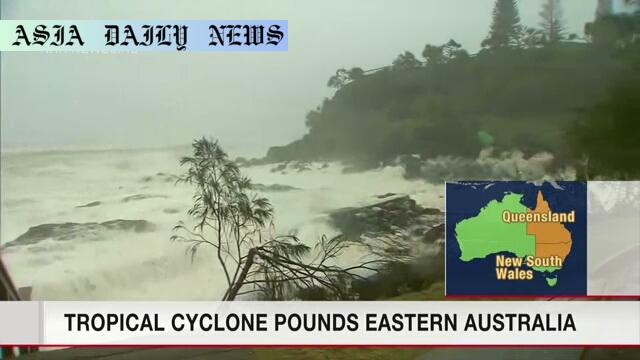Cyclone Alfred disrupts life with heavy rains, strong winds, and floods causing widespread power outages and massive evacuations.
Cyclone Alfred brings torrential rain, strong winds, and severe flooding to eastern Australia.
Over 80,000 homes lost power as the cyclone’s impact widened from southeast Queensland to northern New South Wales.
Evacuation orders impacted tens of thousands as over 1,000 schools remained closed.
Prime Minister Anthony Albanese assured nationwide collaboration for relief measures.

Overview: Cyclone Alfred’s Devastating Impact
Tropical Cyclone Alfred has unleashed its fury on eastern Australia, leaving behind a trail of destruction that continues to expand. The cyclone has brought torrential rains, destructive winds, and towering waves, severely impacting communities across several regions. With over 80,000 households without electricity and tens of thousands of people forced to evacuate, the crisis intensifies as authorities race against time to limit further damage. From southeast Queensland to northern New South Wales, life-threatening flash floods are threatening to engulf areas, pushing emergency systems to their limits.
Humanitarian Crisis and Evacuation Response
The human toll of Cyclone Alfred continues to worsen. Reports indicate that one individual remains missing after being caught in the fast-rising floodwaters. Tens of thousands of residents are under evacuation orders, seeking shelter in overcrowded centers. Schools have been shuttered to ensure student safety, totaling over 1,000 closures. Prime Minister Anthony Albanese has emphasized a unified national response, deploying defense personnel to aid emergency services in this critical hour. His message struck a reassuring tone of solidarity, stating, “The national government has your back at this difficult time.”
Power and Infrastructure Collapse
Infrastructure has taken an enormous hit as Cyclone Alfred’s relentless winds and rains wreak havoc. Power outages, leaving over 80,000 homes in darkness, have compounded the misery of affected communities bracing for further challenges. Public transportation systems are at a standstill, complicating relief operations and everyday functionality. The cyclone has also disrupted supply chains, creating concerns of shortages for essential goods. Emergency workers and local governments are working tirelessly, yet the sheer scale of destruction demands prolonged and intense recovery efforts.
Collaborative Mitigation Efforts
The intergovernmental and community response to Cyclone Alfred reflects the resilience and solidarity of the Australian people. The federal, state, and local governments have seamlessly coordinated to bolster relief responses. Emergency workers are aided by defense force units, ensuring rapid assistance reaches the most critical areas. However, recovery requires a long-term commitment, with thousands of families waiting for immediate aid and support. Prime Minister Albanese’s unequivocal assurance emphasizes that every level of government is committed to providing relief during this unprecedented crisis.
Calls for Climate Awareness and Preparedness
The catastrophic events fueled by Cyclone Alfred reignited discussions on climate change’s impact on extreme weather patterns. Experts caution that incidents of this nature are likely to intensify without a proactive approach to addressing rising temperatures and global warming. Preparing infrastructure, refining evacuation protocols, and boosting community readiness are necessary steps to minimize impact during future disasters. This tragedy serves as a stark reminder that sustainable policies and environmental stewardship must remain at the forefront of national and global priorities.



Commentary
Understanding the Strength of Cyclone Alfred
The devastation left by Cyclone Alfred is a powerful reminder of nature’s raw and uncontrollable force. The images of floods sweeping through neighborhoods and winds toppling power lines bring to light the vulnerability of human life and infrastructure in the face of extreme weather. The impact on schools, evacuations, and public services demonstrates just how thoroughly natural calamities can disrupt society. What stands out, however, is the resilience and commitment shown by Australians to come together in such challenging times.
A Lesson in Preparedness and Action
Australia’s response to Cyclone Alfred highlights the importance of preparedness and multisector collaboration. Communities and governments alike have a role to play in mitigating disaster impacts. The swift deployment of defense forces to assist emergency workers is commendable and proves the effectiveness of having rapid-response plans in place. However, it’s also clear that long-term investments in infrastructure and disaster risk management are critical to reducing vulnerabilities during future events. Cyclone Alfred’s aftermath should encourage policymakers to prioritize such efforts moving forward.
Climate Change: A Bigger Discussion
More difficult to ignore is the growing impact of climate change on events like Cyclone Alfred. Experts indicate we are witnessing stronger, more frequent weather events as the planet warms. It’s a call urging global leaders to push for aggressive climate policies and renewable energy initiatives. As nations observe the devastation Cyclone Alfred has caused to Australia, it should be a wake-up call to work collaboratively on combatting climate change before it exacerbates even more unspeakable tragedies.